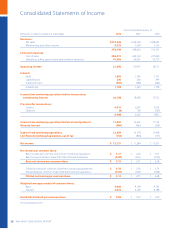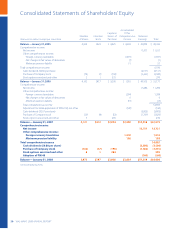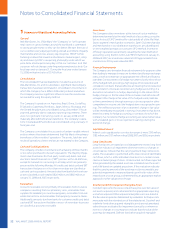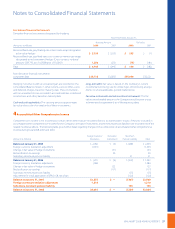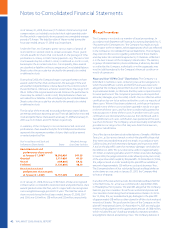Walmart 2008 Annual Report Download - page 36
Download and view the complete annual report
Please find page 36 of the 2008 Walmart annual report below. You can navigate through the pages in the report by either clicking on the pages listed below, or by using the keyword search tool below to find specific information within the annual report.
34 WAL-MART 2008 ANNUAL REPORT
Notes to Consolidated Financial Statements
Wal-Mart Stores and International segments’ distribution facilities in
cost of sales, our gross prot and gross prot as a percentage of net
sales (our “gross margin”) may not be comparable to those of other
retailers that may include all costs related to their distribution facilities
in cost of sales and in the calculation of gross prot and gross margin.
Advertising Costs
Advertising costs are expensed as incurred and were $2.0 billion, $1.9 bil-
lion and $1.6 billion in scal 2008, 2007 and 2006, respectively. Adver-
tising costs consist primarily of print and television advertisements.
Pre-Opening Costs
The costs of start-up activities, including organization costs, related
to new store openings, store remodels, expansions and relocations
are expensed as incurred.
Share-Based Compensation
The Company recognizes expense for its share-based compensation
based on the fair value of the awards that are granted. The fair value
of stock options is estimated at the date of grant using the Black-
Scholes-Merton option valuation model which was developed for
use in estimating the fair value of exchange traded options that have
no vesting restrictions and are fully transferable. Option valuation
methods require the input of highly subjective assumptions, includ-
ing the expected stock price volatility. Measured compensation cost,
net of estimated forfeitures, is recognized ratably over the vesting
period of the related share-based compensation award.
Share-based compensation awards that may be settled in cash are
accounted for as liabilities and marked to market each period. Mea-
sured compensation cost for performance-based awards is recognized
only if it is probable that the performance condition will be achieved.
Insurance/Self-lnsurance
The Company uses a combination of insurance, self-insured retention
and self-insurance for a number of risks, including, without limitation,
workers’ compensation, general liability, vehicle liability and the
Company’s obligation for employee-related health care benefits.
Liabilities associated with these risks are estimated by considering
historical claims experience, demographic factors, frequency and
severity factors and other actuarial assumptions. In estimating our
liability for such claims, we periodically analyze our historical trends,
including loss development, and apply appropriate loss development
factors to the incurred costs associated with the claims. During the
last few years, we have enhanced how we manage our workers’ com-
pensation and general liability claims. As a result, our loss experience
with respect to such claims has improved and the actuarially deter-
mined ultimate loss estimates, primarily for scal year 2004 through
2007 claims, were reduced during the quarter ended July 31, 2007.
The reductions in ultimate loss estimates resulted primarily from
improved claims handling experience, which impacts loss develop-
ment factors and other actuarial assumptions. Due to the benecial
change in estimate of our ultimate losses, accrued liabilities for
general liability and workers’ compensation claims were reduced
by $196 million after tax, resulting in an increase in net income per
basic and diluted common share of $0.05 for the second quarter of
scal year 2008.
Depreciation and Amortization
Depreciation and amortization for nancial statement purposes are
provided on the straight-line method over the estimated useful lives
of the various assets. Depreciation expense, including amortization
of property under capital leases for scal years 2008, 2007 and 2006
was $6.3 billion, $5.5 billion and $4.6 billion, respectively. For income
tax purposes, accelerated methods of depreciation are used with
recognition of deferred income taxes for the resulting temporary dif-
ferences. Leasehold improvements are depreciated over the shorter
of the estimated useful life of the asset or the remaining expected
lease term. Estimated useful lives for nancial statement purposes
are as follows:
Buildings and improvements 5–50 years
Fixtures and equipment 3–12 years
Transportation equipment 3–15 years
Income Taxes
Income taxes are accounted for under the asset and liability method.
Deferred tax assets and liabilities are recognized for the estimated
future tax consequences attributable to dierences between the
nancial statement carrying amounts of existing assets and liabilities
and their respective tax bases. Deferred tax assets and liabilities are
measured using enacted tax rates in eect for the year in which those
temporary dierences are expected to be recovered or settled. The
eect on deferred tax assets and liabilities of a change in tax rate is
recognized in income in the period that includes the enactment date.
Valuation allowances are established when necessary to reduce
deferred tax assets to the amounts more likely than not to be realized.
In determining the quarterly provision for income taxes, the Company
uses an annual eective tax rate based on expected annual income
and statutory tax rates. The eective tax rate also reects the Com-
pany’s assessment of the ultimate outcome of tax audits. Signicant
discrete items are separately recognized in the income tax provision
in the quarter in which they occur.
The determination of our provision for income taxes requires
signicant judgment, the use of estimates, and the interpretation and
application of complex tax laws. Signicant judgment is required in
assessing the timing and amounts of deductible and taxable items
and the probability of sustaining uncertain tax positions. The benet
of uncertain tax positions are recorded in our nancial statements
only after determining a more-likely-than-not probability that the
uncertain tax positions will withstand challenge, if any, from taxing
authorities. When facts and circumstances change, we reassess these
probabilities and record any changes in the nancial statements as
appropriate. Financial Accounting Standards Board Interpretation
(“FASB”) No. 48, “Accounting for Uncertainty in Income Taxes” (“FIN 48”),
eective for the Company for scal year 2008, sets out the framework
by which such judgments are to be made.






